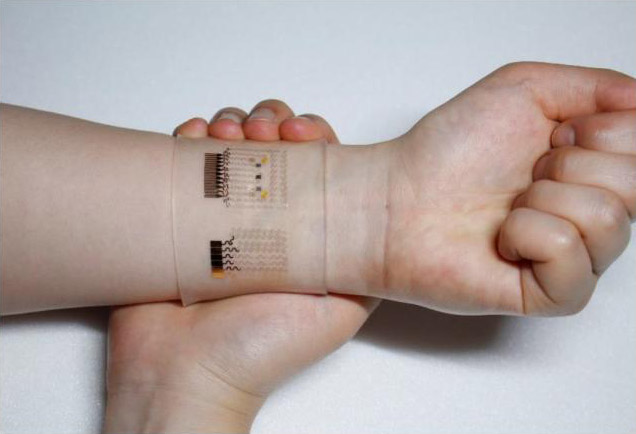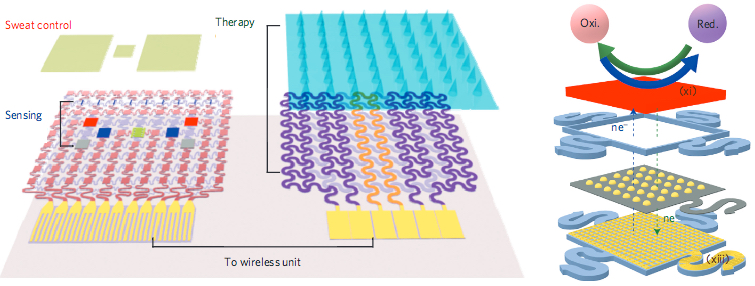A wearable graphene-based biomedical device to monitor and treat diabetes
March 22, 2016

Graphene-based patch for non-invasive blood-sugar diabetes monitoring and painless drug delivery (credit: IBS)
A wearable graphene-based patch that allows for accurate non-invasive blood-sugar diabetes monitoring and painless drug delivery has been developed by researchers at The Institute for Basic Science (IBS) Center for Nanoparticle Research in South Korea.
The device uses a hybrid of gold-doped graphene and a serpentine-shape gold mesh to measure pH (blood acidity level) and temperature by measuring the amount of glucose in sweat. If abnormally high levels of glucose are detected, an insulin drug (such as Metformin) is released into a patient’s bloodstream via drug-loaded microneedles.*

Wireless smartphone monitoring of glucose levels (credit: IBS)
The current treatments available to diabetics are painful, inconvenient, and costly, requiring regular visits to a doctor, the researchers note. Home testing kits are available to record glucose levels, but for treatment, patients have to inject uncomfortable insulin** shots to regulate glucose levels. The IBS device provides non-invasive, painless, and stress-free monitoring of important markers of diabetes using multifunctional wearable devices, reducing lengthy and expensive cycles of visiting doctors and pharmacies, according to the researchers.
“The device shows dramatic advances over current treatment methods by allowing non-invasive treatments,” according to Center for Nanoparticle Research scientist Kim Dae-Hyeong.

Diabetes monitoring and drug-delivery device. (Left) Schematic of diabetes patch, composed of sweat-control (sweat-uptake layer and waterproof film) and sensing (humidity, glucose, pH and tremor sensors) components; (Middle) therapeutic components (microneedles, heater, and temperature sensor); (Right) graphene-hybrid electrochemical unit: electrochemically active and soft functional materials (red), gold-doped graphene (yellow spheres), and serpentine gold mesh (bottom). (credit: Hyunjae Lee et al./Nature Nanotechnology)
* The researchers tested the therapeutic effects by experimenting on diabetic mice. They applied the device near the abdomen of the mouse. Microneedles pierced the skin of the mouse and released Metformin, an insulin-regulating drug, into the bloodstream. The group treated with microneedles showed a significant suppression of blood glucose concentrations with respect to control groups. Two healthy human males also participated in tests to demonstrate the sweat-based glucose sensing of the device. Glucose and pH levels of both subjects were recorded; a statistical analysis confirmed a reliable correlation between sweat-glucose data from the diabetes patch and those from commercial glucose tests.
** Insulin is produced in the pancreas and regulates the use of glucose, maintaining a balance in blood sugar levels. Diabetes causes an imbalance: insufficient amounts of insulin results in high blood glucose levels, known as hyperglycemia. Type 2 diabetes is the most common form of diabetes with no known cure.
Abstract of A graphene-based electrochemical device with thermoresponsive microneedles for diabetes monitoring and therapy
Owing to its high carrier mobility, conductivity, flexibility and optical transparency, graphene is a versatile material in micro- and macroelectronics. However, the low density of electrochemically active defects in graphene synthesized by chemical vapour deposition limits its application in biosensing. Here, we show that graphene doped with gold and combined with a gold mesh has improved electrochemical activity over bare graphene, sufficient to form a wearable patch for sweat-based diabetes monitoring and feedback therapy. The stretchable device features a serpentine bilayer of gold mesh and gold-doped graphene that forms an efficient electrochemical interface for the stable transfer of electrical signals. The patch consists of a heater, temperature, humidity, glucose and pH sensors and polymeric microneedles that can be thermally activated to deliver drugs transcutaneously. We show that the patch can be thermally actuated to deliver Metformin and reduce blood glucose levels in diabetic mice.